



We had hoped for a larger demo in a city of 4 million people, but many passers-by stopped and had a look and asked questions, and we managed to get some worthwhile photos - more yet to come, but a good look at what went on with the cage and the Guantanamo-like orange overalls and the ghastly conditions under which Bradley Manning has been held and tortured by his own government over the period of the last 3 years. The 4th year is about to begin, as is the trial at Fort Meade in Maryland on 3 JUNE 2013.







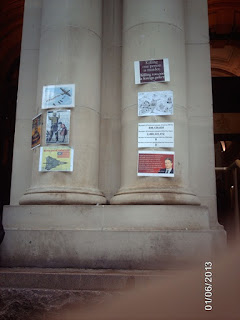













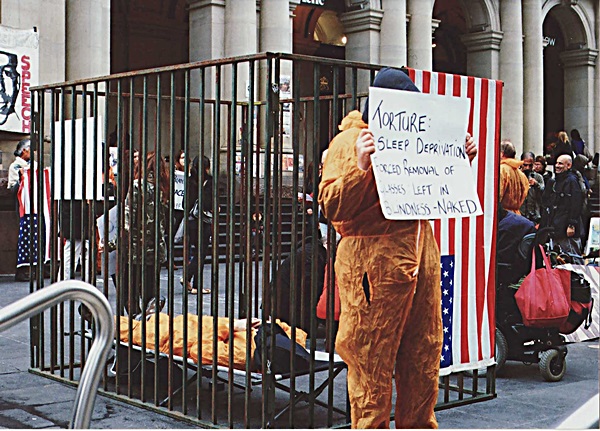

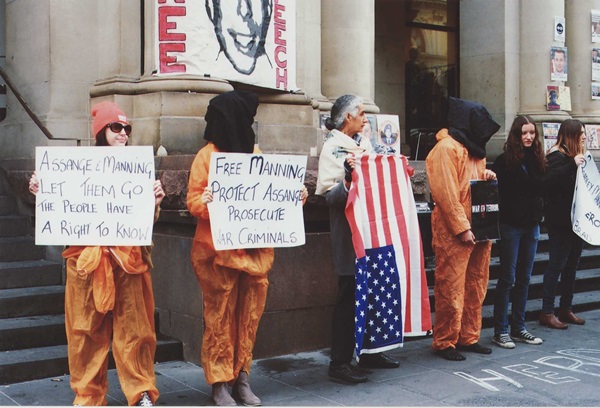
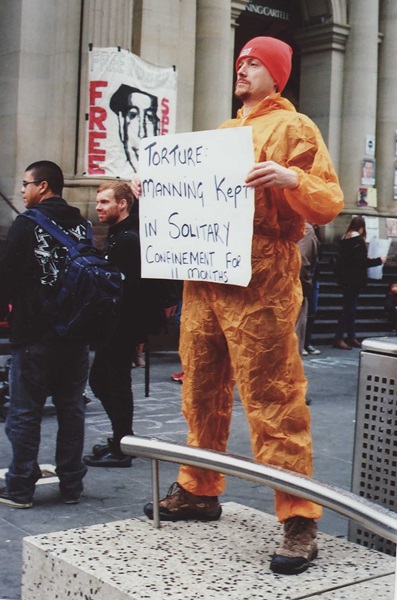
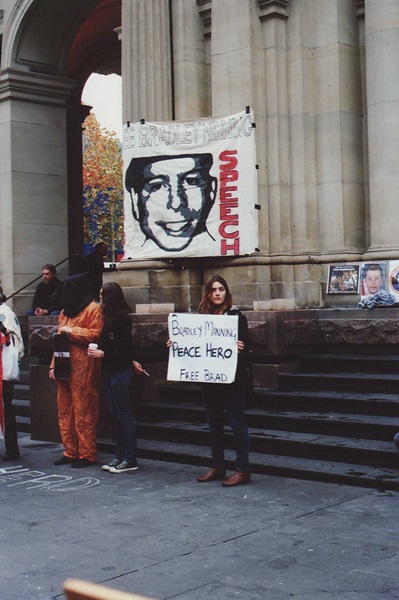
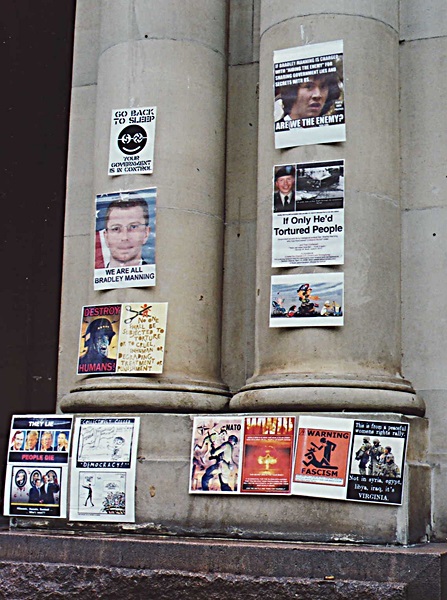
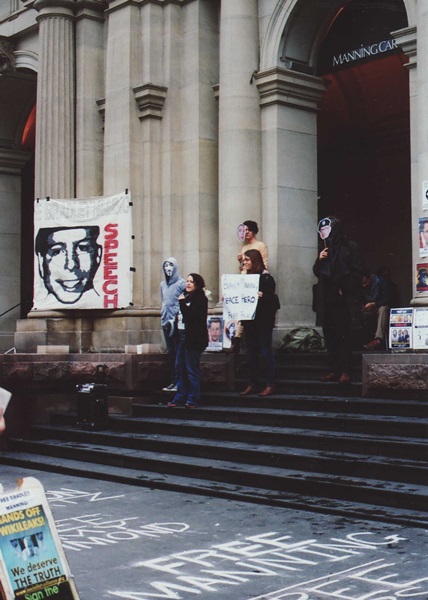
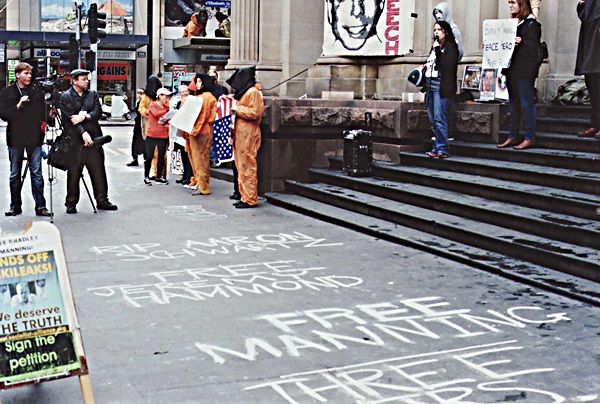
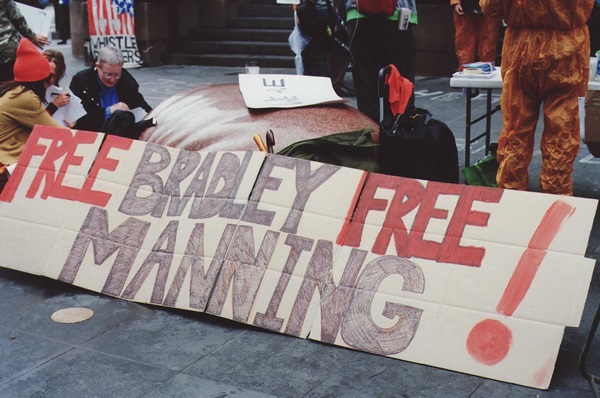

In 2013 in Australia one person complains about an art work and the next thing there is a police raid on the Art Gallery concerned and the Gallery is closed!
We are not talking about 1984 and we are not talking about totalitarian regimes - although sometimes it is hard to tell the difference, but what happened in Melbourne during the first week of June 2013 continues to show that Australia is still firmly embedded in the 19th and early 20th centuries!
The following articles in The Age newspaper are about the censorship of a particular art work and particular gallery which have shown that wowserism, religious bigotry and total ignorance of art lie at the very heart of Australian society with no cure in sight!
Artists push for St Kilda gallery to reopen a week after the seizure of artworks by police.
 Artist Paul Yore. Photo: Luis Enrique Ascui
Artist Paul Yore. Photo: Luis Enrique AscuiPressure is mounting on a St Kilda gallery in the middle of an alleged child pornography controversy to reopen its doors, one week after the seizure of artworks by police.
Artists whose work appears in the Like Mike exhibition at the Linden Centre for Contemporary Arts will on Saturday at 10am protest what has been described as "censorship in the arts" following the seizure of artwork allegedly depicting images of sexual acts with children's faces superimposed.
A police raid last Saturday targeted one installation, Everything's F---ed, (I presume the newspaper report edited Fucked, as if it wasn't used by every second adult and child around the English-speaking world!!) by Melbourne artist Paul Yore, however seven other artists involved in the show were not the subject of police investigation. Linden has been closed all week.
In a letter to the Linden board, co-curator Geoff Newton writes: "We demand to know why the gallery has been closed. The seizure of what has been deemed offensive material in Paul Yore's work is no longer in the gallery and therefore, we are asking for an answer to the question of why the gallery has not been reopened.
"As co curator of the exhibition I, along with the other artists, have not been satisfactorily informed of how any decisions made by Linden board and Director have justified the closure of the gallery. As far as we know the allegations against Paul Yore are as yet unproven.
We demand the gallery be reopened to allow the public to make up their own minds about Paul's work and view the exhibition in its entirety."
Earlier this week police said a 25-year-old Footscray man had been interviewed by detectives and released pending summons. A police spokeswoman said he was likely to face charges including the production and possession of child pornography.
Like Mike was part of a series of exhibitions held across Melbourne galleries in tribute to the late artist Mike Brown, the only Australian artist to be successfully charged with obscenity. Linden chairwoman Sue Foley declined to comment.
-------------------------------------------------------------------------------Why is Linden Gallery still closed?
Protesters outside St Kilda's Linden Gallery question why the 'Like Mike' exhibition remains closed one week after police seized allegedly inappropriate content from artist Paul Yore's installation.
A group of Melbourne artists who have become caught up in the temporary closure of a St Kilda gallery linked to an alleged child pornography controversy say their work is being unfairly censored.
On Saturday morning a large crowd of protesters, which included St Kilda business figures, artists and local MP Martin Foley, staged a rally outside the Linden Centre for Contemporary Arts calling for an end to the censorship of the gallery’s Like Mike exhibition.Linden has remained closed since police raided the gallery more than a week ago.
 Geoff Newton protesting outside the Linden Gallery, St Kilda. Photo: Luis Enrique Ascui
Geoff Newton protesting outside the Linden Gallery, St Kilda. Photo: Luis Enrique AscuiDuring the raid last Saturday, officers seized works by Melbourne artist Paul Yore which allegedly depicted images of sexual acts superimposed with children’s faces.
The police investigation exclusively targeted Mr Yore’s work, leaving the other artists’ work untouched. No charges have been laid.
The Linden board have refused to shed light on the gallery’s fate, despite calls from community leaders to immediately reopen the exhibition.
Although the protesters’ chants of “open up” echoed loudly down St Kilda’s Acland Street, the doors of the gallery remained firmly shut on Saturday.
The Linden Centre’s board was similarly tight lipped, with chairwoman Sue Foley refusing to comment on when the gallery would be open to the public.
Despite repeated attempts to contact the gallery’s board, Like Mike exhibition co-curator Geoff Newton told the scores of protesters on Saturday that he also remained completely in the dark regarding the gallery’s reopening. “We’ve had no answers as to why the gallery has been closed,” he said.
“The police have taken whatever [artwork] that has been in question, and therefore there is nothing left in this exhibition that could be offensive.”
Although the Linden Centre is owned by the City of Port Phillip, a council spokeswoman said an independent curator was responsible for the opening and closing of the gallery.
While the exhibition’s artists await a formal announcement from the Linden centre, State Member for Albert Park District and Shadow Parliamentary Secretary for the Arts Martin Foley blamed the closure of the gallery on “ratbag complainants”.
“They speak for no one,” he said.
“To have their so-called complains blown out of all proportion and to see a gallery closed down like this a dreadful misuse of process.”
While Mr Foley said the police investigation was a separate matter, he called on the St Kilda community to stand by the gallery and its exhibition.
“From what I’ve seen online of [Paul Yore’s] work, I’ve seen just as much, if not more challenging work at some VCE art exhibitions," he said.
“Let not the law be a weapon to close down artist expression.”
The Like Mike exhibition is inspired by Mike Brown, the only Australian artist to be successfully prosecuted for obscenity.
-------------------------------------------------
An earlier exhibit by Paul Yore at Melbourne’s Heide Museum of Modern Art in 2009. Photo: Rodger Cummins Artistic freedom and the threat of censorship are again dominating debate in the art world this week after police raided a St Kilda art gallery, seizing part of an installation. As artist Paul Yore waits to hear if he'll be charged under child pornography laws, civil liberties experts warn that whenever police consider criminal charges against an artist, the consequences are damaging.
''There is no right to not be offended,'' said Michael Stanton, vice-president of Liberty Victoria, in response to the police action at Linden Gallery last Saturday.
Police moved in when a member of the public complained that Yore's installation Everything is F---ed allegedly depicted sexual acts with children's faces superimposed on them.
 Newcastle detectives seize three pictures by Melbourne artist Juan Davila from the Lake Macquarie Community Gallery at Speers Point after they were said to be offensive and indecent. Photo: Newcastle Herald
Newcastle detectives seize three pictures by Melbourne artist Juan Davila from the Lake Macquarie Community Gallery at Speers Point after they were said to be offensive and indecent. Photo: Newcastle HeraldChild pornography offences in Victoria carry a prison term of up to 10 years.
''The experience with Bill Henson in 2008 suggests that police should be very careful when considering bringing such charges against an artist,'' Stanton said. (Police raided a Sydney Henson exhibition that included depictions of naked adolescents, after a complaint by child protection campaigner Hetty Johnston, but the artist was never charged.)
Stanton says he has not seen the Yore exhibit. ''But there is no doubt room for significant disagreement about whether something is pornographic or obscene, all the more so where the purpose of a work is satirical or seeking to explore issues of sexuality and commodification of bodies and images of young persons.''
Arguably we have almost learnt to live with accusations of obscenity and pornography levelled at Australian artists, such as Mike Brown and Juan Davila. Penises and naked women abound in their work, yet the courts have rarely been required. In fact, Brown is the only Australian artist to have been prosecuted for obscenity (ironically, Yore's work was part of a gallery tribute to Brown).
Yet allegations of the inappropriate use of children as subject matter can take condemnation of an artist to a whole new level. Henson, Del Kathryn Barton and Polixeni Papapetrou have been vigorously scrutinised for the images of children in their work; and their supporters' defence of artistic freedom is often a cry in the wilderness.
The Yore case highlights the concern of many in the art world that social fears about child abuse and paedophilia are being displaced onto art - where the chance of real harm occurring to a child or a viewer is unlikely and probably impossible to detect.
Yore has received strong support from his peers this week, including Jason Smith, director of Heide Museum of Modern Art, where Yore has previously exhibited.
''Paul incorporates into his work images and the material detritus of the contemporary world to propose an image of a world gone mad through consumption and gross deregulation,'' Smith says.
''In one sense, his work might be commenting on the sexualisation of young people that anyone sees on a weeknight on commercial television, which can be hair-raising.''
Juan Davila says Yore's collages clearly belong to the language and domain of art. ''Why does our society live in a moral panic?'' he said.
Davila's own work Stupid as a Painter was escorted out of a gallery in 1982, Doug Hall, former Queensland Art Gallery director, points out. Hall questions why contemporary art is singled out for attack by those purporting to represent current community standards.
''Look at Caravaggio's Judith Beheading Holofernes - we love violence as historic allegory and we like sex in all its cultural permutations, we just don't like it in contemporary [art].''
Nevertheless, at QAG he was required to follow the letter of the law when it came to controversial art. ''We might have a view about whether the law is right or wrong, but in a public institution it's irrelevant,'' he says.
Public sentiment is not the only thing at stake for institutions. In Ballarat in 2011, a photograph of a semi-naked girl by Czech Republic artist Jan Saudek was removed from the city's international Foto Biennale following a public complaint. The director at the time said he feared the implications for his gallery's funding. Linden Centre for Contemporary Arts chairwoman Sue Foley issued a brief statement this week saying the gallery, which had co-operated with the police, was ''concerned about the nature of the allegations made against Yore, however it continues to support freedom of expression that has artistic merit. Further comment would be inappropriate as the matter may soon be before the courts,'' she said. The gallery has been closed since the raid. Some art world figures are concerned that the effect of a single complaint (in the Yore, Henson and Saudek cases) can be works removed from view and galleries closed.
''One person complaining shouldn't feel they have the right to set a community standard,'' says Tamara Winikoff, executive director of peak body the National Association for the Visual Arts. ''It has an impact on the gallery and its reputation, on the artist and on all the other artists who lose their exhibition opportunity.''
Police are ''caught in the middle'' legitimately responding to a complaint, but needing to consider what is appropriate freedom of expression, she says, and they lack a set of principles to deal with such complaints. NAVA has advocated intermediary panels of artists and experts that would assess whether a work is legal and whether it is art.
There have been moves to codify the practices of artists working with children. Following the Henson controversy, the Australia Council formed a set of protocols for artists that address the depiction of children and their employment.
But Winikoff believes they were a knee-jerk reaction that ''helped to fuel hysteria''. Designed for grant recipients, they have had a wider impact, making artists more fearful of dealing with images of children, she says. ''They distract public attention from what people should be really worried about, which is genuine child porn … I would bet 100 per cent it had no impact on child porn whatsoever.''
In Liberty Victoria's view, before charges were even contemplated in the Yore case, more consultation with the artistic community and experts should have occurred.
''If the work has artistic merit, and is not mere reproductions of child pornography, then one would have to question how it could be appropriate to bring criminal charges,'' Stanton says. ''I repeat that there is no right to not be offended.''
Jason Smith believes the decision to close the gallery was too swift, and he decries the damage done to Yore's installation by police when they removed several small images.
''The work itself has been destroyed. There's a major deficiency in advocacy for the artist here, and I'm not the only person in the art world who's concerned about the organisational response to this.''
He says that while Linden included warning signs for visitors who might have been offended by images in the work, there had been little concern since for Yore's ''moral rights''.
''I wonder why the gallery didn't lead that discussion before the work was destroyed.
''The hideous issues around child pornography are quite rightly policed and long may it continue.'' However, he rejects any proposal for a formalised body to monitor the content of artists' work as ''too close to censorship.'' Yore has not spoken publicly in the past few days, but immediately after parts of his installation were removed, he said the police action was ''completely absurd''.
''The work I feel has been taken completely out of context because they're very small fragments of a collage of a much larger work that constitute literally thousands of different objects I've found in society - basically junk I've been collecting.''
Therein lies a complicating factor for any potential case against him. As a bower bird gathering objects for installations, where does this leave Yore under the law?
Says Hall: ''It becomes an entirely new invention when artists use a ready-made [object in an art work]. Its purpose is reconfigured, it puts it in a new context and all sorts of new meanings take place.''
Stanton says collage will also create significant difficulties for interpreting if any alleged child pornography offences have occurred.
With images of faces and bodies taken from different mass media sources, how can it be determined whether a child has been harmed in the work's production?
Stanton says that under Victorian legislation, there is a defence to the possession of child pornography that it ''possesses artistic merit''.
''However, there is no such defence to the charge of production of child pornography … The act of 'production' has been defined very broadly by the courts, and it would seem it extends to the creation of artistic works. It has been defined as including downloading an image from the internet.''
Where collage fits within this definition is uncertain.
He points out that Liberty Victoria recognises limits to freedom of expression such as incitement to violence, racial vilification and child pornography.
''A person could not merely place child pornography from the internet into a gallery and then claim it was art. There are limits to that right, but the boundaries between art and pornography are infamously blurred.''
Bernie Geary, Victoria's Principal Commissioner for Children and Young People, is not swayed by arguments that art is a special case.
He has not seen the collage, but says combining images of children with bodies in sexually explicit poses was ''incredibly disrespectful of a vulnerable child''.
Nor is Geary sympathetic to the view of some that Yore's work is a critique and comment on the commodification of children.
''We've got huge problems around the commercial sexualisation of children. But is what [Yore] is doing in the best interests of children or is it just some philosophical jaunt? I'm not sure.''
The blurred boundaries between child pornography and art will continue to bedevil artists and the community at large, and Yore's case is timely, given the recent Victorian Parliament law reform committee's inquiry into ''sexting''.
Stanton said the committee recommended that defences to child pornography charges be standardised ''in light of the danger that sexting activity was being categorised as constituting child pornography offences. The committee did not consider the issue of artistic merit and freedom. The committee recognised that there were different defences to production and possession of child pornography''.
Many of the concerns raised by submission writers to the committee, including Liberty Victoria, noted there was a danger of overcharging people with child pornography offences ''because of the breadth of the definition at law'', he said.
In 2008, then prime minister Kevin Rudd fanned the flames on national television by describing Henson's works - which he had never seen before - as ''revolting''. While he escaped a legal case, the artist was pilloried. Winikoff, among others, believes artists are already self-censoring more than they did pre-2008.
Heide's Smith is not so sure. ''I don't see it or sense it, but I fear it,'' he says. ''Artists make us think in different ways, they are necessary in our lives and they have been for millennia … Yet we live in conservative times.''
Stanton points to the ''danger of censorship having a chilling effect on freedom of expression. Equally, there is a danger that, by fanning the flames of controversy, those who would seek to censor only end up giving more prominence to the issue [and images] in the public realm, where others may seek to capitalise on the controversy for their own ends.''
------------------------------------------We should be talking more, not less, about the blurring of lines between art and pornography.
 Illustration: Matt Davidson.
Illustration: Matt Davidson.The police confiscation of art from a St Kilda gallery last weekend might itself have been scripted as a performance piece, so perfectly does it illustrate the crisis of contemporary censorship.
The offending installation created by collage artist Paul Yore under the prophetic title Everything Is F---ed (Again, who censors the word "Fucked" in 2013?!)apparently features images of sexual acts, on which have been superimposed the faces of children. According to one report, Yore's work includes a ''cardboard cut-out of a child with Justin Bieber's head stuck on, urinating from a dildo into a sink''.
This anatomically improbable image could, in theory, earn Yore 10 years in jail for producing and displaying child pornography.
Ironically, the Yore exhibition was a tribute to avant-garde pioneer Mike Brown, himself successfully prosecuted for obscenity in 1966. Brown's brush with the authorities took place in an Australia in which the censor had only just legalised D.H.Lawrence's Lady Chatterley's Lover and where Chief Censor Prowse was explaining that all horror movies were ''undesirable to the public interest''.
As late as 1972, Queensland officials quoted lyrics from the Rolling Stones' Satisfaction as an example of the ''pathetic nihilism'' against which censorship protected the populace.
The contrast between the Stones and Justin Bieber, the central figure in Yore's collage, nicely illustrates the evolution of the debate.
Back in the day, Mick Jagger spurred a sexual fantasy or two, but Bieber, with 40 million Twitter followers, rules the internet, a realm that makes possible satisfactions of which the censors of 1972 could not have dreamt. The Canadian star's notoriously obsessive fans produce vast archives of Bieberite pornography: images, videos and stories in which Justin does far more than urinate into a sink.
''By day [Bieber is] a teacher adored and loved by all,'' begins a piece of fan-fic accessible after 30 seconds with Google, ''by night nothing but a mystery.'' In this tale, we're told, the teen idol's mysterious evenings feature ''Domination, Submission, Sadism and Masochism, Bondage and Discipline, Murder, Abuse, Alcohol, Deception and Deceit''.
The seizure of Yore's work highlights the dilemma that faces the censorship regime more broadly: simply, the array of pornographic content now available renders any particular prosecution utterly arbitrary and therefore unjust.
The law in Victoria prohibits the sale of X-rated movies, rendering, in theory, the core business of the sex retailers and adult cinemas throughout the state entirely illegal. The police rarely enforce these strictures, for the simple reason that Victorians (who are, statistically, enthusiastic aficionados of porn) would be outraged if they did.
Besides, when consumers can download in seconds almost any content they desire, prosecuting the local adult shop (an institution that already seems slightly quaint) becomes as pointless as, well, raiding an art gallery over images produced without any children engaging in any kind of sex whatsoever.
The crisis of censorship relates to more than technological change. Since the 1980s, the neoliberal turn has introduced market mechanisms into every aspect of our lives, including sexuality, rendering old-fashioned censorship increasingly anomalous. The market makes, after all, no ethical judgments: at the cash register, $100 worth of smut exchanges at the same rate as $100 of biblical tracts.
That's why the old Censorship Board now goes by the name of the Classification Board, presenting its assessments not as moral prohibitions but as tools to facilitate the choices of discerning buyers.
Obviously, that's slightly disingenuous: in the absence of, say, a religiously derived notion of obscenity, consumers might wonder why official ratings should carry any more sanction than, say, reviews on Amazon, particularly since the overwhelming majority of porn in Australia never passes the censor's desk at all. Which is not to say that censorship has disappeared.
A widespread but inarticulate discontent with a market that knows the price of everything and the value of nothing provides the preconditions for regular and explosive moral panics. Think of the unfortunate Bill Henson: one minute, acclaimed for art that hung in Parliament House; the next, denounced by the PM as a menace to the nation's infants.
If such outcries usually centre on children, it's because of the conflicting pressures converging on the modern family. The career of a professional boy-man like Bieber exemplifies the corporate identification of kids as a market segment exploitable like any other, a process that breaks down older ideas of childhood dependence.
Yet, as neoliberalism dissolves the social into the individual, traditional family roles become more ideologically important, with the home offering an apparent haven from dog-eat-dog market competition elsewhere. On the one hand, we now idealise kids as innocent neo-Victorian angels; on the other, every music video shows sexed-up tween stars gyrating knowingly to the beat.
The unease of that contradiction provides obvious opportunities for demagogues and chancers.
The furore over Yore's collage seems to have been initiated by conservative activists, committed to cutting funding to the Linden Centre for Contemporary Art long before the exhibition about which they claim to be outraged.
In a similar fashion, public concern about sexual abuse of children in the NT was unwittingly channelled into draconian censorship laws applied exclusively to indigenous communities, in a direct contradiction of the Little Children are Sacred report's recommendations.
In response to raids on galleries, it's tempting to defend the work in question as art rather than porn. That's a mistake - and not simply because Brown's oeuvre (like that of so many modern artists) calls into question the distinction between the two. Too often, critics assert the privileged status of art to imply the incapacity of ordinary people to comment on the work in question, thus feeding the old stereotypes about haughty artistic elitists looking down on the public who fund them.
Actually, art should foster widespread debate on important issues - and that's precisely why Yore's exhibition should be defended.
To put it another way, we need to talk more, not less, about how sexuality plays out in the world we have created for ourselves. Such conversations matter too much to be shut down by police.
Jeff Sparrow is the editor of Overland and the author of Money Shot: A Journey into Porn and Censorship.
Article in The Guardian UK:
David Miranda, partner of Guardian interviewer of whistleblower Edward Snowden, questioned under Terrorism Act

Glenn Greenwald (right) and his partner David Miranda, who was held by UK authorities at Heathrow airport. Photograph: Janine Gibson
The partner of the Guardian journalist who has written a series of stories revealing mass surveillance programmes by the US National SecurityAgency was held for almost nine hours on Sunday by UK authorities as he passed through London's Heathrow airport on his way home to Rio de Janeiro.
David Miranda, who lives with Glenn Greenwald, was returning from a trip to Berlin when he was stopped by officers at 8.05am and informed that he was to be questioned under schedule 7 of the Terrorism Act 2000. The controversial law, which applies only at airports, ports and border areas, allows officers to stop, search, question and detain individuals.
The 28-year-old was held for nine hours, the maximum the law allows before officers must release or formally arrest the individual. According to official figures, most examinations under schedule 7 – over 97% – last less than an hour, and only one in 2,000 people detained are kept for more than six hours.
Miranda was released, but officials confiscated electronics equipment including his mobile phone, laptop, camera, memory sticks, DVDs and games consoles.
Since 5 June, Greenwald has written a series of stories revealing theNSA's electronic surveillance programmes, detailed in thousands of files passed to him by whistleblower Edward Snowden. The Guardian has also published a number of stories about blanket electronic surveillance by Britain's GCHQ, also based on documents from Snowden.
While in Berlin, Miranda had visited Laura Poitras, the US film-maker who has also been working on the Snowden files with Greenwald and the Guardian. The Guardian paid for Miranda's flights.
"This is a profound attack on press freedoms and the news gathering process," Greenwald said. "To detain my partner for a full nine hours while denying him a lawyer, and then seize large amounts of his possessions, is clearly intended to send a message of intimidation to those of us who have been reporting on the NSA and GCHQ. The actions of the UK pose a serious threat to journalists everywhere.
"But the last thing it will do is intimidate or deter us in any way from doing our job as journalists. Quite the contrary: it will only embolden us more to continue to report aggressively."
A spokesperson for the Guardian said: "We were dismayed that the partner of a Guardian journalist who has been writing about the security services was detained for nearly nine hours while passing through Heathrow airport. We are urgently seeking clarification from the British authorities."
A spokesperson for Scotland Yard said: "At 08:05 on Sunday, 18 August a 28-year-old man was detained at Heathrow airport under schedule 7 of the Terrorism Act 2000. He was not arrested. He was subsequently released at 17:00."
Scotland Yard refused to be drawn on why Miranda was stopped using powers that enable police officers to stop and question travellers at UK ports and airports.
There was no comment from the Home Office in relation to the detention. However, there was surprise in political circles and elsewhere. Labour MP Tom Watson said he was shocked at the news and called for it to be made clear if any ministers were involved in authorising the detention.
He said: "It's almost impossible, even without full knowledge of the case, to conclude that Glenn Greenwald's partner was a terrorist suspect.
"I think that we need to know if any ministers knew about this decision, and exactly who authorised it."
"The clause in this act is not meant to be used as a catch-all that can be used in this way."
Schedule 7 of the Terrorism Act has been widely criticised for giving police broad powers under the guise of anti-terror legislation to stop and search individuals without prior authorisation or reasonable suspicion – setting it apart from other police powers.
Those stopped have no automatic right to legal advice and it is a criminal offence to refuse to co-operate with questioning under schedule 7, which critics say is a curtailment of the right to silence.
Last month the UK government said it would reduce the maximum period of detention to six hours and promised a review of the operation on schedule 7 amid concerns it unfairly targets minority groups and gives individuals fewer legal protections than they would have if detained at a police station.
The government of Brazil issued a statement in which it expressed its "grave concern" over the detention of one of its citizens and the use of anti-terror legislation. It said: "This measure is without justification since it involves an individual against whom there are no charges that can legitimate the use of that legislation. The Brazilian government expects that incidents such as the one that happened to the Brazilian citizen today are not repeated."
Widney Brown, Amnesty International's senior director of international law and policy, said: "It is utterly improbable that David Michael Miranda, a Brazilian national transiting through London, was detained at random, given the role his partner has played in revealing the truth about the unlawful nature of NSA surveillance.
"David's detention was unlawful and inexcusable. He was detained under a law that violates any principle of fairness and his detention shows how the law can be abused for petty, vindictive reasons.
"There is simply no basis for believing that David Michael Miranda presents any threat whatsoever to the UK government. The only possible intent behind this detention was to harass him and his partner, Guardian journalist Glenn Greenwald, for his role in analysing the data released by Edward Snowden."

Article in The Age:
Using the Terrorism Act to detain a journalist's partner is a gross abuse of power.

Journalist Glenn Greenwald walks with his partner David Miranda in Rio de Janeiro's International Airport. Photo: Reuters
It's been an infuriating few days for anyone who values the freedom of the press, as authorities in Britain resorted to the tactics of tyrants and thugs to squelch reporting that they simply don't like.
In acts clearly calibrated for optimal intimidation, they have detained the partner of a journalist, threatened to shut down a reporting operation that has prompted a critical public debate over government spying, and forced the destruction of a major publication's computer hard drives.
It's breathtaking in its audacity - and if it comes to light that the US government took any part in these acts, it will warrant immediate congressional investigation.

NSA whistleblower Edward Snowden. Photo: Reuters
As it is, accelerating assaults on investigative journalism demand stronger protections for journalists and their sources. Otherwise, Western society will forsake its right to know what happens in the back rooms of a government that purportedly exists to serve democratic interests.
On Sunday morning, the partner of Glenn Greenwald, the Guardian newspaper columnist who broke most of the recent blockbuster stories about US government surveillance efforts, was detained at Heathrow Airport for nine hours under Britain's broad terror laws. Authorities interrogated David Miranda without a lawyer and confiscated his laptop, phone, memory sticks and other devices.
Miranda was returning from Berlin, where he met a filmmaker who worked with Greenwald on stories based on leaks from former US National Security Agency contractor Edward Snowden.
Schedule 7 of the British Terrorism Act grants authorities wide latitude to search and question travellers to ascertain any link to terrorism. But it's clear Miranda's detention had nothing to do with terrorism, since Greenwald reported that those nine hours were spent questioning him about the NSA reporting.
Using laws designed to ferret out suspected terrorists to detain a person aiding acts of journalism is a cut-and-dried abuse of government power, an act of intimidation that may well be illegal - and certainly should be. It gives the lie to the naive but oft-repeated notion that if you've done no wrong, you have nothing to fear.
British officials justified their actions by suggesting Miranda was ''in possession of highly sensitive stolen information that would help terrorism''. But many things can be construed as ''helping'' terrorism. Osama bin Laden recommended a Bob Woodward book for its insights into US military decision-making, but that doesn't mean anyone with a copy in his or her carry-on luggage should be dragged off a plane.
The White House acknowledged that it was given a ''heads-up'' about Miranda's detention, but said it occurred ''without the involvement - and not at the request - of the United States government''. An equally shocking set of revelations arrived on Monday, as Guardian editor Alan Rusbridger published a story disclosing that British officials have demanded that the newspaper relinquish or destroy all the material leaked by Snowden. He was warned that if the newspaper refused to do so, the government would force its hand in court.
Rusbridger told authorities that most of the reporting on the NSA stories was already happening out of New York. But his argument was unpersuasive.
''And so one of the more bizarre moments in The Guardian's long history occurred - with two [government intelligence] security experts overseeing the destruction of hard drives in The Guardian's basement just to make sure there was nothing in the mangled bits of metal which could possibly be of any interest to passing Chinese agents,'' Rusbridger said.
The good news: the publication had digital copies of the material outside the country. But the mere fact that a Western democracy raided an independent publication and shattered its property is outrageous, a tilt towards the totalitarianism imagined by George Orwell.
Such attacks on investigative journalism appear to be escalating. Judges have threatened reporters at The New York Times and Fox News with jail time for refusing to disclose their sources. The Obama administration has prosecuted more people under the Espionage Act for leaking classified information than all past presidencies combined.
Veteran investigative reporters say the current climate has cast a chill across the landscape. Once-reliable sources now refuse to step forward for fear of winding up the next Bradley Manning, the WikiLeaks leaker.
There's a high price to pay for these policies: we'll know less about what governments, businesses, lobbyists and other institutions are doing behind closed doors. Unless we demand stronger protections for journalists and their sources, we forfeit a victory to idiocy, incompetence, abuse and crime.
James Temple is a columnist for the San Francisco Chronicle.
Maybe we are reverting to the dark ages when the "masses" were illiterate and knowledge was limited and education was only for the very privileged.
Those days are over? Well, not exactly!
A current art exhibition which is showing at an art gallery in Melbourne uses the fuck word in its title. But this word is forbidden to the Melburnians because the newspapers publicising information about the exhibition are writing the word as f--k! Oh dear, how pathetic!
In a separate but unrelated episode, a very famous "left-wing" blog has censored out the use of the word sex, sending it out in articles as "s-x".
These are both examples of self-censorship and what we were very accustomed to in South Africa during the apartheid police state years.
When are they all going to grow up and stop doing the work of the censors for them. What, after all, are they paid for? In any event the new conservative government will be even more reactionary than the previous conservative government, and censorship will soon increase even more alarmingly.
Here are two recent articles from The Age newspaper about artist Paul Yore and his new exhibition and his forthcoming prosecution of a previous exhibition on grounds of child pornography after ONE complaint from a member of the public who paid for admission to a gallery to be able to make the complaint:
Paul Yore, artist, was charged by Victoria Police after officers seized some of his artwork from a St Kilda gallery for child porn. Seen here with his latest piece.

Melbourne artist Paul Yore, who will face court in November on charges of possessing and producing child pornography, has vowed to continue creating art that deals with his recurrent themes of sex and popular culture.
Ahead of two new exhibitions of his work in Melbourne and Sydney, Yore has spoken about the impact of the controversial seizure of pieces from his Everything is F---ed installation at St Kilda's Linden Centre for Contemporary Arts in June.
''With the police raid, that's a response that I could have never imagined for the work,'' he told Fairfax Media.
''But in a weird way, in dealing with the despair of the situation that I'm currently in, what I've taken from it is a reaffirmation of the need to make such work, the need to put things together from society that shows and reveals what they are."
Police moved on the Linden exhibition after acting on a complaint from a member of the public, seizing parts of Yore's work that allegedly showed images of sex acts with children's faces superimposed.
In what is expected to become a landmark case testing the boundaries of artistic expression, charges were laid against Yore on Friday.
City gallery Neon Parc, whose owner Geoff Newton curated the Like Mike show at Linden featuring the controversial Yore work, will reveal Yore's latest piece Fountain of Knowledge on Wednesday. Made during a recent residency at the Australian Tapestry Workshop, the large, hand-stitched wall hanging is trademark Yore: figures frolic around a central phallus spraying a rainbow of beads and felt applique. It is bordered by squares spelling ''playland'' and ''dystopia''.
Mr Newton is also taking another Yore piece, a huge site-specific installation, to the inaugural Sydney Contemporary art fair next week.
**********************************************************Arts on Wednesday -Dan Rule speaks to Paul Yore, the man behind the controversy.
Besieged artist Paul Yore challenges our pop-cultural prism.
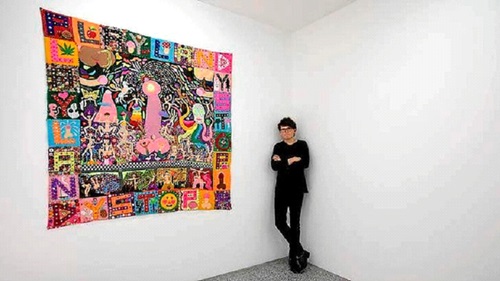
Paul Yore seems relieved to be talking about art.
Softly spoken and articulate, the 25-year-old prefaces his wildly colourful and expansive work with a particular consideration and scrutiny. Collecting, compiling and reconstituting discarded toys, consumerist objects, pop-cultural posters and texts, Yore's immersive sculptural installations and hyper-detailed needlepoint works have garnered acclaim in art circles for their playful broaching of identity politics, sexuality, consumerist excess and the power of vernacular images and texts.
''I've always seen text as an extension of the assemblage or collage, where you're taking disparate sources and mashing them together,'' he says of his work, which has been shown at Heide Museum of Modern Art, Gertrude Contemporary, Federation Square, various council and artist-run galleries, and will be on show at city gallery Neon Parc from Wednesday (although its official opening is Thursday night). ''I'm really obsessed by this idea that a Britney Spears lyric could be just as important as a Socratic fragment.''
The statement points to both the playfulness and critical intent of Yore's often homoerotic work, which acknowledges the power of language, pedagogy and the pervasiveness and implications of pop-cultural images and objects. In works such as his vast installation at the Substation gallery in Newport this February, shrines to Justin Bieber, urinating dildos, phallic totems, sensor-triggered robotics and sound and psychedelic needlepoint knotted and coalesced.
''There's definitely an archaeological or anthropological approach that runs through the work,'' says Yore, who studied painting and anthropology at Monash University. ''It's partly about the potential to transform what is depressing shit into something that at least acknowledges the meaninglessness and wastefulness of it.''
But it's the sexualised content within Yore's work that brought him all the wrong kind of publicity in June, when a segment of his installation, Everything is F---ed - showing at Linden Centre for Contemporary Arts in St Kilda as part of a tribute exhibition to the late Mike Brown (who in 1966 became the only Australian artist to be successfully prosecuted for obscenity) - was seized by police following a complaint from an audience member. Last Friday, days after the announcement of Yore's new show at Neon Parc, Fountain of Knowledge, he was charged with producing and possessing child pornography. The charges have rocked the Melbourne art world and several people, including prominent artist Juan Davila, have come out in defence of the young artist. Speaking on Monday, Neon Parc director Geoff Newton, who curated the exhibition from which Yore's works were seized and will show his work at the coming Sydney Contemporary art fair, said only that the charges ''will be vigorously defended''.
Acting on legal advice, Yore is unwilling to comment on the charges. However, Fountain of Knowledge, his large-scale felt-applique work for his exhibition at Neon Parc, suggests he's also unwilling to shy away from the homoerotic themes for which he's become known, with naked male figures dancing around a hot-pink phallic totem, the words ''playland'' and ''dystopia'' bordering the image.
Yore describes the work, which he created as part of a residency at the Australian Tapestry Workshop following the events at Linden, as ''rainbow coloured, psychedelic and a bit apocalyptic with dark undercurrents'', the dualistic qualities of place and culture playing out in a colourful schism.
''This particular piece is about language acquisition,'' says Yore. ''This idea that at a young age you're taught to make these linguistic differentiations and you're kind of stuck with that. And they're these really deep-rooted dualistic things, like male or female or colours that reduce an endless spectrum to this really limited set of categories, like red or green.''
Yore says that the events at Linden have only reaffirmed his commitment to making such work. ''With the police raid, that's a response that I could have never imagined for the work … in a weird way, in dealing with the despair of the situation that I'm currently in, what I've taken from it is a reaffirmation of the need to make such work, the need to put things together from society that shows and reveals what they really are.
''This new work is a response partly to what has happened,'' he says. ''I'm still willing to broach phallic imagery and homoerotic imagery in my work because that's not a crime.''
Fountain of Knowledge is on until October 5 at Neon Parc.


TIME Magazine asked WikiLeaks whistleblower PVT Chelsea Manning what she’s thankful for this year. Her answer was published alongside those from Michelle Obama, Joe Biden, and 14 other well-known public figures. Her response, while demonstrating wisdom beyond her years, is one that many people who work for the betterment of society will appreciate:
“I’m usually hesitant to celebrate Thanksgiving Day. After all, the Puritans of the Massachusetts Bay Colony systematically terrorized and slaughtered the very same Pequot tribe that assisted the first English refugees to arrive at Plymouth Rock. So, perhaps ironically, I’m thankful that I know that, and I’m also thankful that there are people who seek out, and usually find, such truths. I’m thankful for people who, even surrounded by millions of Americans eating turkey during regularly scheduled commercial breaks in the Green Bay and Detroit football game; who, despite having been taught, often as early as five and six years old, that the “helpful natives” selflessly assisted the “poor helpless Pilgrims” and lived happily ever after, dare to ask probing, even dangerous, questions.
Such people are often nameless and humble, yet no less courageous. Whether carpenters or welders; retail clerks or bank managers; artists or lawyers, they dare to ask tough questions, and seek out the truth, even when the answers they find might not be easy to live with.
I’m also grateful for having social and human justice pioneers who lead through action, and by example, as opposed to directing or commanding other people to take action. Often, the achievements of such people transcend political, cultural, and generational boundaries. Unfortunately, such remarkable people often risk their reputations, their livelihood, and, all too often, even their lives.
For instance, the man commonly known as Malcolm X began to openly embrace the idea, after an awakening during his travels to the Middle East and Africa, of an international and unifying effort to achieve equality, and was murdered after a tough, yearlong defection from the Nation of Islam.
Martin Luther King Jr., after choosing to embrace the struggles of striking sanitation workers in Memphis over lobbying in Washington, D.C., was murdered by an escaped convict seeking fame and respect from white Southerners. Harvey Milk, the first openly gay politician in the U.S., was murdered by a jealous former colleague. These are only examples; I wouldn’t dare to make a claim that they represent an exhaustive list of remarkable pioneers of social justice and equality—certainly many if not the vast majority are unsung and, sadly, forgotten.
So, this year, and every year, I’m thankful for such people, and I’m thankful that one day—perhaps not tomorrow—because of the accomplishments of such truth-seekers and human rights pioneers, we can live together on this tiny “pale blue dot” of a planet and stop looking inward, at each other, but rather outward, into the space beyond this planet and the future of all of humanity.“
For those who don’t already know, PVT Chelsea Manning grew up in a conservative community in the Midwest. She suffered a dysfunctional home life, and she was bullied at school for being gay. She was even homeless for a period, working two part-time jobs to get by. She dreamed of one day going to college, and for this reason joined the Army at the age of 19. A few years later she realized she was not gay, but transgender; since she was in the Army, her only option was to hide her identity while working 14 hour days in a war zone. Through all these obstacles, she has remained committed to educating herself, asking the hard questions, and taking risks in the name of helping other people.
This year, we give thanks for PVT Manning’s humanist idealism, her bravery, and her unyielding belief that through the work of dedicated individuals our society can and will be made more just.
It is not only her actions, but also her unique individualism, that has inspired thousands of people around the world to action. We hope you’ll join us in showing thanks for Chelsea by making a gift to ensure her legal appeals process is fully funded. 35 years is far too harsh a punishment for showing the public the truth.
Donate to Support the Legal AppealsSo far we’ve raised just over $16,000 of the $40,000 needed. Please help us meet our goal by Chelsea’s birthday on December 17th.
********************************************************************************
With your continued help, we'll be fighting to win justice and freedom for US Army Pvt. Chelsea (formerly Bradley) Manning in the New Year. Outrageously sentenced to 35 years in prison for sharing information with the public, her actions aided people worldwide, sparking crucial debate about democracy, transparency and US foreign policy. Now, this American Prisoner of Conscience has shared her specific and personal legal goals going forward with us, and we need to raise $40,000 to fund these efforts that include her legal fees, family visits, transitioning and education.
Chelsea has already spent longer than she deserves in prison, but we can brighten her world by reaching this goal for her 26th birthday next week (December 17th).
Her fate is far from sealed – if we continue to fight. She has already fulfilled many of her stated aims by raising awareness about the need for more government transparency, inspiring activists and whistle-blowers like Edward Snowden.
Now Chelsea is asking for your help with the following:*Legal fees – We are pursuing every avenue for a reduction in sentence. These include the petition for a pardon, now in front of President Obama, and a clemency request to be submitted to the Convening Authority later this month – which will include hundreds of letters from supporters like you. Next year the Army Court of Appeals will review the case, followed by the Armed Forces Court of Appeals. If those come up short, Chelsea's annual Parole and Clemency Review will begin in 2019.
*Visitation – Since the majority of Chelsea's family has limited financial resources, grassroots donations can help support the legal defence in arranging visits, especially from her mother and relatives living in Wales.
*Transitioning – Years prior to the trial, Pvt. Manning began a process of questioning her gender. Following the trial, she demonstrated how she values individual transparency in much the same way she values government transparency. She came our publicly as transgender, and expressed a desire to identify as a female named Chelsea Elizabeth Manning. She now wishes to undergo hormone therapy at Fort Leavenworth, the goal of which is to allow an individual to appear physically more similar to how they feel on the inside. Although the US Military has historically refused transgender individuals the right to express themselves openly, given the significant time Chelsea may spend in military prison, her legal defence will work for both a legal name change and hormone therapy without delay.
* Higher Education – One of Chelsea's dreams, and one of the primary reasons she joined the Army, was to obtain a college education. Chelsea wishes to enroll at a university on the East Coast and work toward a degree. The Private Manning Support Network plans to assist he financially in this endeavour.
When Chelsea blew the whistle, she affected millions of people worldwide, as well as mass movements for government transparency and against human rights violations of the War on Terror. The only way a movement can be successful, however, is if thoes individuals who step forward to make brave decisions feel supported. Please contribute today so that she can see her family more often, continue fighting her legal battle, receive appropriate medical treatment, and pursue an education.
|
Courage to Resist hosts the Pvt. Chelsea Manning Defence Fund in collaboration with the Private Manning Support Network. We were responsible for 100% of Chelsea's legal expenses through her court-martial - and now we're covering her ongoing defence expenses, including legal appeals, pardon petition, gender related issues, and family visits. If you wish your contribution to be earmarked only for Pvt. Manning, simply note that on your donation. Otherwise, we'll use it to support Chelsea as well as other objectors. |

Below this article is a video from Democracy Now relating to a film on Aaron Swartz's life shown at the Sundance Film Festival recently
---------------------------------------------------------------------------------------------------------From The Age Good Weekend:
By Paul McGeough
Computer genius and online activist Aaron Swartz wanted to change the world - one download at a time. Then the US government decided enough was enough, with tragic consequences. By Paul McGeough.
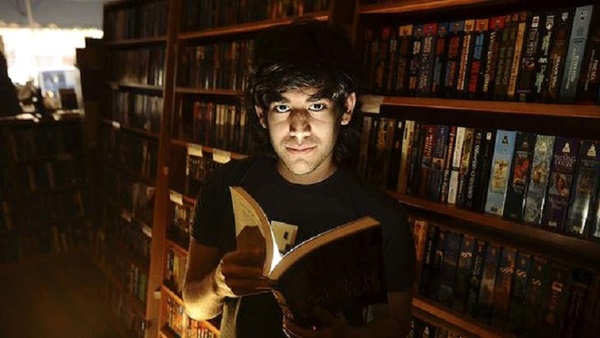
His mind raced as the taxi hurtled towards Brooklyn. Sam McLean had dropped in for drinks with mates at an office in SoHo, in Lower Manhattan and now, as the cab crossed the East River, he was assailed by a rising sense of unease.
The day had started badly. He'd been supposed to meet his friend Aaron Swartz for brunch, but his calls and texts had gone unanswered. Miffed, McLean had arranged with Swartz's Australian-American girlfriend, Taren Stinebrickner-Kauffman, for the gang to gather for dinner.
He did not commit suicide, he was killed by the government.
As national director of the Australian activist movement GetUp!, McLean, then 25, was on a Manhattan stopover after attending a retreat for online activists from around the world in Holmes, 80 kilometres north of New York City. There, the Online Progressive Engagement Networks (OPEN) had taken over a conference centre to "collectively dream and scheme about the future".

At about 7pm, McLean's mobile rang - a frantic call from Ben Margetts, another member of the Australian activist network in New York, insisting he get to the apartment Swartz shared with Stinebrickner-Kauffman urgently. Soon came another call, this time from an agitated Stinebrickner-Kauffman demanding to know how long he'd be.
Less than 10 minutes later, McLean piled out of the taxi into a rainy evening. Barrelling into the newish apartment block, he took the elevator to the seventh floor. The door was open and a stricken Stinebrickner-Kauffman, 32, and Margetts, 27, were standing outside. Swartz was inside, dead, they told him. When she got home that afternoon, his girlfriend had found him hanging by his belt from a window jamb. It was January 11, 2013.
Variously described as a genius, wunderkind and prodigy, 26-year-old Aaron Swartz had become a rock star in a burgeoning, global internet-based activist movement. From his early teens, he had bent an agile mind and a rare wizardry with computers to a self-appointed mission that he often, and perfectly seriously, described as saving the world.
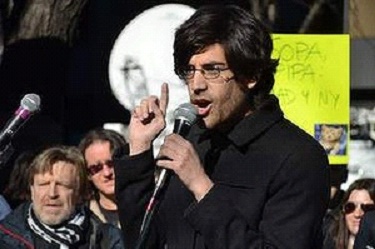
Stinebrickner-Kauffman, his girlfriend since 2011, had been so worried about what Swartz might do to himself that morning that she'd tried to prevent him going to the bathroom alone. Unable to reach him through the day, she was so filled with a sense of foreboding on her return to the apartment that as she rode up in the elevator, as she later told The New Yorker, she readied her mobile to be able to dial 911 immediately.
On entering, she found Swartz hanging from the window. He was still in the clothes he'd been wearing when she'd left that morning: black V-neck T-shirt, brown corduroy trousers and jacket.
There was no suicide note.
Police and paramedics brought Swartz down from the window jamb and by the time McLean entered, the body had been zipped into a black bag. McLean grabbed a few things for the deeply shocked Stinebrickner-Kauffman and, with Margetts, they headed to the nearby home of another activist friend, American Ben Wikler.

Aaron Swartz committed suicide just two days after federal prosecutors in Boston had rejected his last bid to avoid jail time. Two years earlier, he'd been busted using the Massachusetts Institute of Technology (MIT) network to download almost 5 million documents ordinarily locked behind a pay-wall on one of the world's most preeminent scholarly archives, JSTOR - a conflation of "journal storage".
When the prosecutors hit Swartz with a raft of charges, under which he might have been jailed for decades, the plea-bargaining process became a stalemate. Swartz rejected any outcome that would brand him for life as a felon when he believed he'd committed no crime; prosecutors insisting, on the other hand, that he was guilty and must do time.
Simon Sheikh, the Canberra-based activist entrepreneur and a failed Greens candidate at the 2013 federal election, was also at the OPEN summit in upstate New York early last year. As McLean's predecessor at GetUp!, Sheikh had first reached out to Swartz the previous year. Swartz was then working for Avaaz, a relatively new, online, global activist movement drawing followers by the millions, and Sheikh had been keen to tap into its campaign inventiveness.
Later, he'd introduced Swartz to the leadership at ThoughtWorks, a privately owned company with a staff of thousands working across the globe to revolutionise software design for positive social change. In April 2012, the organisation snapped up Swartz as a software developer.
Both Sheikh and McLean spent time with Swartz in New York that went way beyond the pro-forma office appointments and conference interactions they might have expected. What was to be a one-hour meeting at the ThoughtWorks office on Madison Avenue, says Sheikh, became a talkfest on machine learning environments that went into the early hours of the next day and reconvened a day later at a restaurant in Brooklyn.
At Holmes, Swartz dragged McLean up to an attic room, where they huddled for hours as he shared his latest dramatic thinking. McLean remembers being struck by what he considered an oddly phrased afterthought. "He told me he had cracked his idea on how to change the world," McLean remembers. "And [he said] he would do it that year - or he would die."
Later, Swartz's collaborator at the Edmond J. Safra Centre for Ethics at Harvard, law professor Lawrence Lessig, described his complex young friend in these terms: "Aaron was a hacker. But he was not just a hacker. He was an internet activist, but not just an internet activist. Indeed, the most important part of Aaron's life is the part that most run over too quickly - the last chunk, when he shifted his focus from this effort to advance freedom in the space of copyright, to an effort to advance freedom and social justice more generally."
Recently, when I track Sam McLean, now 27, to a beach house on the south coast of NSW, he tells me in a Skype video exchange: "We all can see the world one way and think that it should be another way, but most don't feel they have the agency and a responsibility to [change it]. Aaron believed he had both."
Simon Sheikh noticed a healthy tension when Swartz was in a room. "Even without speaking, he could communicate his disappointment with ideas that were not well formed and with people whose values did not match his own," he says. "His values were simple, clear, pure - and he wouldn't budge."
On the night Swartz died, McLean and the others set up a memorial website. Within days, there were tens of thousands of tributes from around the world. "Aaron Swartz is what I wish I was," wrote an introspective John Atkinson. "I am a bright technologist, but I've never built anything of note. I have strong opinions about how to improve this world, but I've never acted to bring them to pass ... If I were able to stop being afraid of what the world would think of me, I could see myself making every decision that Aaron made that ultimately led to his untimely death. This upsets me immensely."
Aaron Swartz, the eldest of three sons, was born in 1986 to bookish parents Robert and Susan in affluent Highland Park, 30 kilometres north of Chicago. By the age of three, he'd taught himself to read. Robert, a 63-year-old computer consultant, remembers his son as an exceptionally bright, inquisitive boy who picked up things quickly.
Aaron grew up with the internet - and was fascinated by it. "He was interested in computers because they were interesting - not because he might go off to Silicon Valley to become another Mark Zuckerberg," Robert tells me recently when we meet at his Chicago office-workshop.
Robert and Susan didn't worry when, complaining of being bored, Aaron opted to drop out of high school after year 9. "I had felt the same thing at school, so it didn't surprise me at all," says the father now. But his parents did worry about his health. All his life, Aaron had suffered from debilitating bouts of ulcerative colitis, a digestive malady with similar symptoms to Crohn's disease. He ate only "white" foods - cheese, bread, rice, eggs, pasta, and tofu and cheese pizza. His friend Ben Wikler tells a story of Swartz coming to dinner and eating nothing but bread because he did not want to burden his hosts with his dietary demands.
Swartz hated to impose himself on others. In the days before he died, he was hugely stressed by the realisation he would have to ask others to help fund his legal defence. Similarly, he was acutely uncomfortable in dealing with the likes of waiters and cabbies because of the power imbalance he perceived in his relationship with them.
As a boy, Swartz insinuated himself into online internet hacking workshops, stunning older collaborators with his computing genius. In photos from back then, first as a 12-year-old and then through his early teens, he can be seen in his trademark ill-fitting T-shirts, sometimes looking like the tag-along child of an adult participant.
Among other projects, Swartz designed a Wikipedia-like site called The Info Network, which was selected as a finalist in the prestigious ArsDigita contest for teen programmers. He then launched watchdog.net, an online political activist website. By the age of 14, he was already considered "a figure in the industry", sharing the heavy-lifting in a team that invented the RSS format that updates websites - news reports, blogs and the like. At 15, he became a co-founder of the Creative Commons copyright-sharing organisation.
Just as he had dropped out of high school, he also quit Stanford University after his freshman year. On day 58, he blogged: "Kat and Vicky want to know why I eat breakfast alone reading a book, instead of talking to them. I explain to them that however nice and interesting they are, the book is written by an intelligent expert and filled with novel facts. They explain to me that not sitting with someone you know is a major social faux pas and not having a need to talk to people is just downright abnormal. I patiently suggest that it is perhaps they who are abnormal ... They patiently suggest I'm being offensive and best watch myself if I don't want to alienate the few remaining people who still talk to me."
At 19, he moved to Cambridge, near Boston in Massachusetts, where he co-founded Reddit, the social news and entertainment website accessed by millions, which was subsequently acquired by Condé Nast Publications in October 2006. Afterwards, he was required to move to California to work in the office of the Condé Nast-owned Wired magazine, an arrangement that had been a condition of the Reddit buyout. He hated the demands of his conventional new job and on his first day at Wired locked himself in a bathroom and cried. "I was miserable," he said later. "I couldn't stand office life. I couldn't stand Wired." He told a flatmate he was heading back to Boston because San Francisco didn't have enough books.
From his new base, Swartz launched OpenLibrary, a vast online book and data repository that these days is accessed free of charge by millions. After that, he co-designed Strongbox, by which sources could anonymously drop documents to The New York Times without fear of disclosure, then SecureDrop, which allowed whistleblowers to communicate with journalists without revealing their identity. He also founded Demand Progress, an online activist website.
The thread running through all his endeavours was a passion for computers, online freedom and freedom of information. Its ultimate expression was his obsession with the web as a vehicle for social and political campaigning - especially his leadership role in a 2012 campaign that spectacularly defeated a bid by Hollywood and the music industry to have Washington rubber-stamp the proposed Stop Online Piracy Act, which activists claimed would severely curtail internet freedom.
Stinebrickner-Kauffman, who became romantically involved with Swartz just weeks before he was formally charged, laid out for reporters what she described as a finely honed aesthetic sense: "[Aaron] could get deeper, truer joy [than anyone I've met] out of a perfect corn muffin, a brilliantly constructed narrative arc, a beautiful font." But she added, "He was human. He wasn't happy at every moment and I'd be the first to say he could be a real pain to live with."
Certainly, as the JSTOR case began to gather momentum, those around him noticed signs of growing paranoia. His friend Alec Resnick recalled sitting in a car-share vehicle with Swartz, who would insist on putting all their electronic devices outside it and turning up the radio volume, to guard against eavesdropping. Soon after his arrest, he proposed setting up his Linux server to record any sounds at the door so he'd know if "they" were coming. Worried by prosecutors' bully-boy tactics, his lawyers warned them that Swartz had become a suicide risk.
Swartz's death brought dramatic focus to a global insurgency war in which information is power and the battlefield is the net. In the words of Glenn Greenwald - the former Guardian journalist who reported on much of the Edward Snowden disclosures on the reach of Washington's global and domestic spying network - this is a "war over how the internet is used and who controls the information that flows on it, and [Swartz's] real crime in the eyes of the US government [was that he] challenged its authority and those of corporate factions to maintain a stranglehold on that information."
While at a conference of hackers held in Eremo, Italy, in 2008, Swartz was one of a group of activists who wrote what became known as the Guerilla Open Access Manifesto. Running to just 600 words, it begins: "Information is power. But like all power, there are those who want to keep it for themselves." It ends with this exhortation: "There is no justice in following unjust laws ... We need to take information, wherever it is stored, make our copies and share them with the world."
Swartz was putting this manifesto into practice when he hacked into JSTOR in 2010. First, he created a script to download JSTOR documents, then he hardwired his new laptop into the MIT network from a closet in a building on the Boston campus. Using a fake profile, he programmed the laptop to suck in a motherload of information over a period of months.
Swartz dodged efforts by MIT's cyber security team to shut him down while he downloaded almost 5 million documents, nearly the entire JSTOR archive. Unknown to him, however, the campus cyber sleuths were able to locate the laptop and to train a surveillance camera on the closet to record his comings and goings.
He was arrested on January 6, 2011, after abandoning his bicycle and attempting to escape on foot in a street near the Harvard University campus in Cambridge. Later, when Aaron and his father Robert went to collect the abandoned bicycle from the MIT campus police, an officer told them he was keeping Aaron's USB drive. "It's all in the hands of the Secret Service now," he told them. Robert can't now remember which of them asked, as they walked away, "What's the Secret Service involved for?"
This wasn't Aaron Swartz's first such caper. In 2006, Swartz had got his hands on the Library of Congress's bibliographic dataset, access to which ordinarily required payment of a fee. Swartz made it available free on his OpenLibrary and got away with it - because, as a government-owned document, the dataset was without copyright.
By 2008, the year in which he helped write the Guerilla Open Access Manifesto, he'd become more daring. Exploiting a government trial that allowed limited online access to court documents, he moved almost 3 million of them from the Public Access to Court Electronic Records website to offer them free outside the usual costly and cumbersome system of access. The FBI opened an investigation that went nowhere. Again, these were public documents without copyright.
Swartz might have thought he was nipping through a similar loophole with the JSTOR material. The MIT network was open to all on campus, so he wasn't hacking the system. And as a research fellow at nearby Harvard, where he was studying political corruption, he had legitimate access to JSTOR, which charges institutions such as MIT as much as $50,000 a year for access. Further, there was no real complainant. As soon as the data was returned to JSTOR, the archive's management refused to co-operate with authorities.
It has never been clear what Swartz planned to do with the JSTOR files. Had he made the download just to make a point? It is almost certain, given his ideology, that he didn't intend to personally profit from it. The initial reaction of Massachusetts state prosecutors suggested that here was a stunt in keeping with a colourful history of student pranks at MIT. They were examining the possibility of a simple breaking-and-entering charge when they were elbowed aside by their federal counterparts.
This time, the Feds ignored the copyright issue. Instead, they went for Swartz under a much-criticised 1980s statute, the Computer Fraud and Abuse Act (CFAA), alleging he had accessed a "protected computer" and had done so "without authorisation". Despite the "victimless" nature of the case, Washington's chief prosecutor in Boston, Carmen Ortiz, defended the severity of the charges.
"Stealing is stealing, whether you use a computer command or a crowbar, and whether you take documents, data or dollars," she declared. "It is equally harmful to the victim whether you sell what you have stolen or give it away."
Initially, Swartz was indicted on four charges: wire fraud, computer fraud, unlawfully obtaining information from a protected computer and recklessly damaging the protected computer. He could have gone down for 35 years and been fined $US1 million but, despite the seriousness implied in all that, prosecutors were set to bargain it away to just six months in jail - if he would plead guilty.
Swartz was horrified. Jail would be awful enough, but he couldn't countenance having the career-destroying term "convicted felon" permanently attached to his résumé. When he baulked in the negotiations, the prosecutors doubled down, belting him with another raft of charges under which he would face 50 years inside.
The bulk of these charges were under the CFAA, a law so badly written that in 2012, Judge Alex Kozinski of the Ninth Circuit Court ridiculed prosecutors in a similar case: "Under the government's proposed interpretation of the CFAA ... describing yourself as 'tall, dark and handsome' [on a dating website] when you're actually short and homely will earn you [jail time]." In an era of hacker threats to corporate and government websites and mainframes, it seemed Federal authorities wanted to make an example of Swartz.
"Aaron did not commit suicide, he was killed by the government," his father said at the time of his death. When I meet him in Chicago, he elaborates: "The response of the prosecutors was totally out of proportion compared to what he had done."
He characterises the prosecution as "cruel, vindictive, sadistic" and later ticks off the names of the key characters in the drama - Carmen Ortiz, US Attorney General Eric Holder and MIT president Rafael Reif. "They all say they acted appropriately; none has said they made a mistake."
The opposing reactions of the two revered academic institutions involved was also vexing for the Swartz family. Why would MIT sit on its hands, seemingly happy to leave Swartz to the mercy of prosecutors determined to make an example of him, when JSTOR was determined to make it known it did not want to see him in the dock?
The stark contrast between the two performances was on public view two days before Swartz died, when JSTOR announced that all the files he had downloaded would become available free over the internet. Forty-eight hours later, the archive's management acknowledged Swartz as "a truly gifted person who made important contributions to the development of the internet and the web from which we all benefit".
Describing the JSTOR download as "like a pie in the face" - by which he meant annoying for the victim but of no lasting consequence - Columbia Law School professor Tim Wu invoked the names of "two other eccentric geniuses": Apple co-founders Steve Jobs and Steve Wozniak. "In the 1970s, [they] committed crimes similar to, but more economically damaging than, Swartz's," he wrote.
"Those two men hacked AT&T's telephone system to make free long-distance calls and actually sold the illegal devices [to others] to make money ... Jobs and Wozniak were never prosecuted [and] instead got bored ... and built a computer. The great ones always operate at the edge."
In january 2013, Swartz was excited about the future of the web as a campaign tool - and what organisations such as his Demand Progress and Australia's GetUp! might achieve. Invigorated by the success of the campaign to derail the Stop Online Piracy Act (SOPA), he wanted to map out a new age of citizen power. He warned in his SOPA victory speech: "It will happen again. Sure, it will have another name, and maybe another excuse, and it will do its damage in a different way. But make no mistake: the enemies of the freedom to connect have not disappeared."
In his attic meeting with McLean during the OPEN summit at Holmes, Swartz had sketched the contours of a new order, in which he envisaged corporate power being severely weakened and political parties replaced by internet-based people power. In contrast to efforts by activists such as Edward Snowden and Julian Assange, who sought to reduce state power that derived from secrecy, Swartz's objective was to build citizen power to counter that of governments and corporations. He revealed a grand design by which he envisaged artificial intelligence making activists such as himself and McLean redundant.
"He knew it had to be big enough to combat that kind of [corporate] power," McLean recalls. "The idea was Fordian, as in mass production. Being able to automate or to build computer intelligence around numbers of increasing scale and power. He was working on an intelligent logarithm - artificial intelligence - to devolve leadership to lower organisational levels.
"His argument was that we'll have to fight more SOPA-style campaigns. So we need an algorithm or computer program that would encourage lots of people to identify the fights and to start the campaigns. We'd put the tools that we have at our disposal in their hands."
The following evening, Thursday, January 10, Swartz was one of a small group at Spitzer's Corner, a bar on Manhattan's Lower East Side. The technologist and blogger Andy Baio, 36, reported seeing a seemingly happy Swartz who was "deep in conversation, smiling and chatting".
"denial is a wonderful thing, but it wears off," Robert Swartz tells me. "I can distract myself and make it seem like it didn't happen but, as time goes by, reality becomes more strange."
He dwells on his son's pain: "I miss Aaron terribly. It was incredibly hard on him. He was devastated and it made him sick. You could see the stress he was under." In sidestepping the drudgery of school and college, is it possible Aaron missed an opportunity to acquire skin that might have served as an extra layer of protection in life? Was he less resilient for having missed these rites of passage? "This may have happened," Robert allows.
Stinebrickner-Kauffman, now the founder and director of SumOfUs, a San Francisco-based corporate and government watchdog group, declined to be interviewed for this story, but told The Guardian last year, "I think I understand how it happened, [but] the biggest problem with the decision is that it's permanent. Other dumb decisions, you can usually recover from."
I ask Sam McLean if there was an inflexibility in Swartz's temperament, by which he couldn't face doing what he didn't want to do, and McLean tweaks the construct: it was more about Swartz not being able to do what he so wanted to do. "Perhaps his excitement and suicide were sides of the same coin - every goal he believed he could and must achieve was also something he might not be able to achieve," he ventures. "It was a sword of Damocles. He knew all of his plans could be kyboshed by a ridiculous law and a petty prosecutor."
What is it like now on the activist ramparts without his friend? "It's scary without Aaron," says McLean. "We relied on him to be brilliant."
---------------------------------------------------------------------------------------------------------
See also:

Contact me at: red-jos_at_red-jos_net

Mannie De Saxe also has a personal web site, which may be found by clicking on the link: RED JOS: HUMAN RIGHTS ACTIVISM
Mannie's blogs may be accessed by clicking on to the following links:
MannieBlog (from 1 August 2003 to 31 December 2005)
Activist Kicks Backs - Blognow archive re-housed - 2005-2009
RED JOS BLOGSPOT (from January 2009 onwards)

This page created 10 JUNE 2013 and updated 4 JULY 2021
PAGE 78